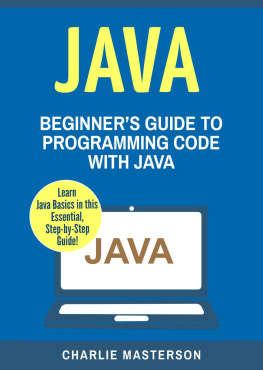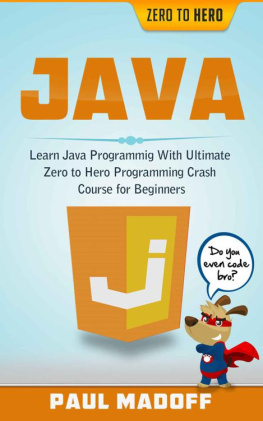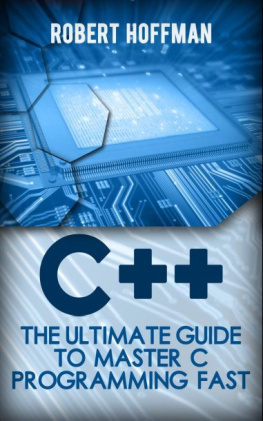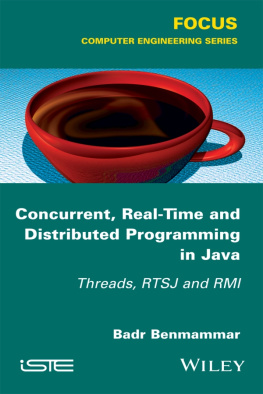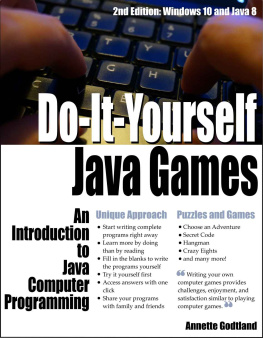Enjoy Awesome Books - Distributed programming and Java EE
Here you can read online Enjoy Awesome Books - Distributed programming and Java EE full text of the book (entire story) in english for free. Download pdf and epub, get meaning, cover and reviews about this ebook. year: 2020, genre: Computer. Description of the work, (preface) as well as reviews are available. Best literature library LitArk.com created for fans of good reading and offers a wide selection of genres:
Romance novel
Science fiction
Adventure
Detective
Science
History
Home and family
Prose
Art
Politics
Computer
Non-fiction
Religion
Business
Children
Humor
Choose a favorite category and find really read worthwhile books. Enjoy immersion in the world of imagination, feel the emotions of the characters or learn something new for yourself, make an fascinating discovery.

- Book:Distributed programming and Java EE
- Author:
- Genre:
- Year:2020
- Rating:3 / 5
- Favourites:Add to favourites
- Your mark:
- 60
- 1
- 2
- 3
- 4
- 5
Distributed programming and Java EE: summary, description and annotation
We offer to read an annotation, description, summary or preface (depends on what the author of the book "Distributed programming and Java EE" wrote himself). If you haven't found the necessary information about the book — write in the comments, we will try to find it.
Distributed programming and Java EE — read online for free the complete book (whole text) full work
Below is the text of the book, divided by pages. System saving the place of the last page read, allows you to conveniently read the book "Distributed programming and Java EE" online for free, without having to search again every time where you left off. Put a bookmark, and you can go to the page where you finished reading at any time.
Font size:
Interval:
Bookmark:

 JAVA 13: DISTRIBUTED PROGRAMMING AND JAVA EE SOFTWARE DEVELOPMENT Java 13: Distributed programming and Java EE: Software Development 1 st edition 2018 Poul Klausen & bookboon.com ISBN 978-87-403-2098-5 Peer review by Ove Thomsen, EA Dania
JAVA 13: DISTRIBUTED PROGRAMMING AND JAVA EE SOFTWARE DEVELOPMENT Java 13: Distributed programming and Java EE: Software Development 1 st edition 2018 Poul Klausen & bookboon.com ISBN 978-87-403-2098-5 Peer review by Ove Thomsen, EA Dania 
 CONTENTS Foreword Introduction Java persistence API 2.1 An improved address program Exercise 2.2 Related tables Problem Enterprise Java Beans 3.1 A stateful session bean 3.2 A remote Singleton session bean Exercise 3.3 EJB and JPA Exercise 3.4 Transactions 3.5 Interception 3.6 3.7 3.8 4.1 Qual ifi ers 4.2 5.1 6.1 7.1 7.2 7.3 7.4 Client cert ifi cate 7.5 Programmer d efi ned authentication A fi nal example 8.1 8.2 8.3 FOREWORD T h is book is the thirteenth in a series of books on software development. T h e programming language is Java, and the language and its syntax and semantics f i lls obviously much, but the books have also largely focus on the process and how to develop good and robust applications. T h is book is a continuation of the subjects in Java 11, but with focus on the development of enterprise applications. T h ey are programs that performs their work using components or services hosted on d i f f erent computers and located on d i f f erent places, which communicate and coordinate their work over a network. Primary topics are Java EE technologies as JPA, EJB and Web Services. T h e book requires knowledge of programming of web applications similar to what has been dealt with in the books Java and Java As the title says this series of books deals with software development, and the goal is to teach the reader how to develop applications in Java.
CONTENTS Foreword Introduction Java persistence API 2.1 An improved address program Exercise 2.2 Related tables Problem Enterprise Java Beans 3.1 A stateful session bean 3.2 A remote Singleton session bean Exercise 3.3 EJB and JPA Exercise 3.4 Transactions 3.5 Interception 3.6 3.7 3.8 4.1 Qual ifi ers 4.2 5.1 6.1 7.1 7.2 7.3 7.4 Client cert ifi cate 7.5 Programmer d efi ned authentication A fi nal example 8.1 8.2 8.3 FOREWORD T h is book is the thirteenth in a series of books on software development. T h e programming language is Java, and the language and its syntax and semantics f i lls obviously much, but the books have also largely focus on the process and how to develop good and robust applications. T h is book is a continuation of the subjects in Java 11, but with focus on the development of enterprise applications. T h ey are programs that performs their work using components or services hosted on d i f f erent computers and located on d i f f erent places, which communicate and coordinate their work over a network. Primary topics are Java EE technologies as JPA, EJB and Web Services. T h e book requires knowledge of programming of web applications similar to what has been dealt with in the books Java and Java As the title says this series of books deals with software development, and the goal is to teach the reader how to develop applications in Java. It can be learned by reading about the subject and by studying complete sample programs, but most importantly by yourself to do it and write your own programs from scratch. T h erefore, an important part of the books is exercises and problems, where the reader has to write programs that correspond to the substance being treated in the books. All books in the series is built around the same skeleton and will consist of text and examples and exercises and problems that are placed in the text where they naturally belongs. T h e d i f f erence between exercises and problems is that the exercises largely deals with repetitions of the substance that is presented in the text, and furthermore it is relatively accurately described what to do. Problems are in turn more loosely described, and are typically a little bigger and there is rarely any clear best solution. T h ese are books to be read from start to f i nish, but the many code examples, including exercises and problems plays a central role, and it is important that the reader predict in detail studying the code to the many examples and also solves the exercises and problems or possibly just studying the recommended solutions.
All books ends with one or two larger sample programs, which focus primarily is on process and an explanation of how the program is written. On the other hand appears the code only to a limited extent if at all and the reader should instead study the f i nished program code perhaps while testing the program. In addition to show the development of programs that are larger than the examples, which otherwise is presented, the aim of the concluding examples also is to show program examples from varying f i elds of application. Most books also ends with an appendix dealing with a subject that would not be treated in the books. It may be issues on the installation of software or other topics in computer technology, which are not about software development, but where it is necessary to have an introductory knowledge. If the reader already is familiar with the subject, the current appendix can be skipped.
T h e programming language is, as mentioned Java, and besides the books use the following products: NetBeans as IDE for application development MySQL to the extent there is a need for a database server (from the book Java 6 onwards) GlassFish as a web server and application server (from the book Java onwards) It is products that are free of charge and free to install, and there is even talk about products, where the installation is progressing all by itself and without major e f f orts and challenges. In addition, there are on the web detailed installation instructions for all the three products. T h e products are available on Windows and Linux, and it therefore plays no special role if you use Linux or Windows. All sample programs are developed and tested on machines running Linux. In fact, it plays no major role, as both Java and other products work in exactly the same way whether the platform is one or the other. Some places will be in the books where you could see that the platform is Linux, and this applies primarily commands that concerning the f i le system.
Otherwise it has no meaning to the reader that the programs are developed on a Linux machine, and they can immediately also run under Windows unless a program refers to the f i le system where it may be necessary to change the name of a f i le. F inall y a littl e abou t wha t th e book s a r e not . I t i s no t h o w t o write o r fo r tha t matte r reference manuals in Java, but it is as the title says books on software development. It is my hope that the reader when reading the books and through the many examples can f i nd inspiration for how to write good programs, but also can be used as a source collection with a number of examples of solutions to concrete everyday programming problems that you regularly face as a software developer. INTRODUCTION In the previous two books, I have been working on developing web applications, and this book is a natural continuation, but focusing on the development of distributed programs. T h ey are programs that perform their work using components or services hosted on d i f f erent computers, which communicate and coordinate their work over a network.
T h e whole idea is that these components largely have their own lives and live independently of each other and generally without knowing the clients who uses the services they provide. In fact, it is not easy to precisely d e f i ne what we understand with a distributed program, but typically we will understand a program that is characterized by that there are several independent computing units (computers), each of which has their own local memory the computing units communicate by sending messages to each other over a network T h e goal of a distributed program (or system) may be to solve a particular task, and users will then perceive the family of computing units as a single device (or system), but instead, they may be a service-oriented system that o f f ers a range of services which users can use and perceive as shared resources. Distributed programs will also be characterized by parallelity, where multiple activities are performed simultaneously on multiple computers and locations. You can also sometimes see distributed programming described as a further development of object-oriented programming. An object-oriented program consists of objects with each of their internal data and logic hidden from the outside world and only known through the services that the object makes available in the form of public methods. T h ese objects then work together to solve the task to be solved.
Similarly, you can see a distributed program as a program that solves the task by providing a number of services that live independently of each other on computers around the world where applications can use them if they otherwise will be allowed. In addition to showing how to develop distributed programs in practice (or perhaps more in relation to this), the goal is also to describe more spec i f i c technologies as in headings are - Java Persistence API - Java Enterprise Beans - Contexts and Dependency Injection - Java Web Services - RESTFul web services - Java EE security As it appears, the book describes a number of Java APIs, and much of the substance is directly related to NetBeans and GlassFish. JAVA PERSISTENCE API In the previous books (from Java 6 onwards) and including Java 11 on web applications, I have considered several examples that uses databases. It has always included programming an object oriented encapsulation of the database in the form of model classes for each of the database tables and one or more classes that encapsulates the SQL statements that will manipulate the content of the relational database. T h is has meant that for each example, many lines have been required to write the Java code, and although it may be a f f ordable, as it is in principle the same thing that should happen every time, it can be done easier (and better) , as Java EE o f f ers an API called Java Persistence AP I , which has the exact task of o f f ering an object-oriented interface to a relational database. T h e aim of this chapter i s t o gi ve a n int r oductio n t o thi s A P I , an d th e conten t largel y characteri z e s h o w t o d o .
Font size:
Interval:
Bookmark:
Similar books «Distributed programming and Java EE»
Look at similar books to Distributed programming and Java EE. We have selected literature similar in name and meaning in the hope of providing readers with more options to find new, interesting, not yet read works.
Discussion, reviews of the book Distributed programming and Java EE and just readers' own opinions. Leave your comments, write what you think about the work, its meaning or the main characters. Specify what exactly you liked and what you didn't like, and why you think so.

